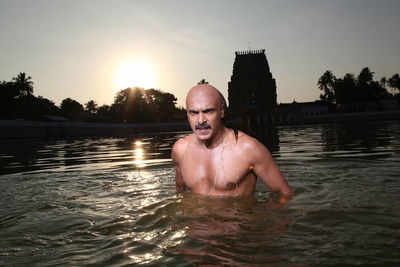- News
- entertainment
- kannada
- movies
- Upendra's top 3 take-aways from Shivam
Trending
This story is from December 22, 2014
Upendra's top 3 take-aways from Shivam
Upendra talks about all that he's learnt from his upcoming film Shivam

When you’re shooting for a film that highlights religion, learning about the history and the logic behind various religious rules and traditions is inevitable. Kannada star Upendra says his soon-to-be-released film Shivam proved to be one such learning experience. He lets us in on three interesting traditional facts that had him impressed during the shoot of the film.Here’s what he has to say…
1. I have recited a lot of Sanskrit shlokas in the film, for my Brahmin avatar. One of them talks about the three white lines that we draw over our forehead. It is called the Basma Naama Bare. Colloquially, we use the term Hanne Bhara, which translates to destiny. We believe that whatever happens to us is part of our destiny that is pre-written, on our forehead as it were. But the Basma Naama apparently has the power to change one’s destiny, quite like the word Basma itself that translates to ‘finish’ or ‘to put an end to.’
2. The architecture of our temples is such that it depicts the human body — this also denotes that our body is our temple too. So you see that the garbha, or the shrine where the idol is kept, is exactly in the area of the temple where the heart of a human body would be. And the aatma, or the God, lives in the heart.
3. You will see a Basavanna (the bull) sitting outside the shrine at every Shiva temple. The Basavanna is also always seen facing the shrine. This shows us the kind of concentration and devotion that we should have towards God —wherein you are constantly thinking of God and are in prayer and praise of your God.
1. I have recited a lot of Sanskrit shlokas in the film, for my Brahmin avatar. One of them talks about the three white lines that we draw over our forehead. It is called the Basma Naama Bare. Colloquially, we use the term Hanne Bhara, which translates to destiny. We believe that whatever happens to us is part of our destiny that is pre-written, on our forehead as it were. But the Basma Naama apparently has the power to change one’s destiny, quite like the word Basma itself that translates to ‘finish’ or ‘to put an end to.’
2. The architecture of our temples is such that it depicts the human body — this also denotes that our body is our temple too. So you see that the garbha, or the shrine where the idol is kept, is exactly in the area of the temple where the heart of a human body would be. And the aatma, or the God, lives in the heart.
3. You will see a Basavanna (the bull) sitting outside the shrine at every Shiva temple. The Basavanna is also always seen facing the shrine. This shows us the kind of concentration and devotion that we should have towards God —wherein you are constantly thinking of God and are in prayer and praise of your God.
End of Article
FOLLOW US ON SOCIAL MEDIA









